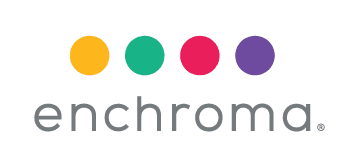National Science Foundation Awards EnChroma Grant for Contact Lenses for Color Blindness
– NSF Funds Development of Contact Lens Version of the Industry’s Leading Eyewear Designed to Help People with Color Vision Deficiency (CVD) –
Berkeley, CA – July 15, 2024 – EnChroma® – creators of glasses for color blindness – today announced that the National Science Foundation (NSF) has awarded an SBIR Phase I grant to the company to develop contact lenses based on its innovative eyewear for those with deuteranomaly and protanomaly red-green color blindness, the most prevalent types.
“We are grateful for the funding provided by the National Science Foundation that will help us create more efficacious, convenient and affordable solutions for millions of color blind people,” said Erik Ritchie. “When fully developed and approved for use in the U.S., the technology will make daily-wear contact lenses available for some of the estimated 13 million Americans with hereditary red-green color blindness, and 30 million with acquired diffuse color blindness. We are proud of EnChroma’s scientific team and their commitment to continuous innovation.”
Dr. Don McPherson will serve as the lead Principal Investigator for the grant. He co-developed the patented technology for the contact lenses along with EnChroma’s Chief Chemist, Dr. Sunil Koovakkat.
“Sunil and I are quite honored that the NSF has recognized the novelty and importance of the underlying chemistry behind EnChroma’s design, which will lead to an affordable assistive contact lens for red-green color blindness,” said Dr. Don McPherson, Chief Science Officer (CSO) and cofounder of EnChroma. “In particular, Sunil’s amazing work on forming stable solutions of hydrophobic dyes in hydrophilic polymers advanced our science to the point where a contact lens for colorblindness was feasible.”
Color Vision Deficiency (CVD) affects one in 12 men (8%) and one in 200 women (.5%), an estimated 13 million people in the US and 350 million people worldwide. While people with normal color vision see over one million colors, those with red-green color blindness only see an estimated 10% of hues and shades. As a result, colors containing red or green can appear dull, muted and indistinguishable. This can cause frustration with daily tasks involving color, issues in school or at work, limit access to certain occupations, and detract from fully experiencing colorful artwork, nature or other aspects of life.
Contact lenses are considered more effective than eyeglasses because they alter 100% of the light entering the eye. While EnChroma’s industry-leading eyewear runs $189-$349 per pair the disposable, daily wear contact lenses are expected to cost significantly less and will be covered by vision plans. The lenses will offer a wider application of EnChroma’s patented technology.
The projected timeline for the EnChroma contact lenses to reach market is approximately four years. The NSF grant runs for one year until April 2025. Follow-on phase II funding transpires over two years, followed by the lenses’ subsequent development and FDA approval, which is projected to take a year.
About EnChroma
Based in Berkeley, Calif., EnChroma produces leading-edge eyewear for color blindness and low vision, and other solutions for color vision, sold online and through Authorized Retailers worldwide. Invented in 2010, EnChroma’s patented eyewear combines the latest in color perception, neuroscience and lens innovation to improve the lives of people with color vision deficiency around the world. EnChroma received an SBIR grant from the National Institutes of Health (NIH). It earned the 2020 Innovation Award in Life Sciences from the Bay Area’s East Bay Economic Development Alliance. For more information, visit enchroma.com.
